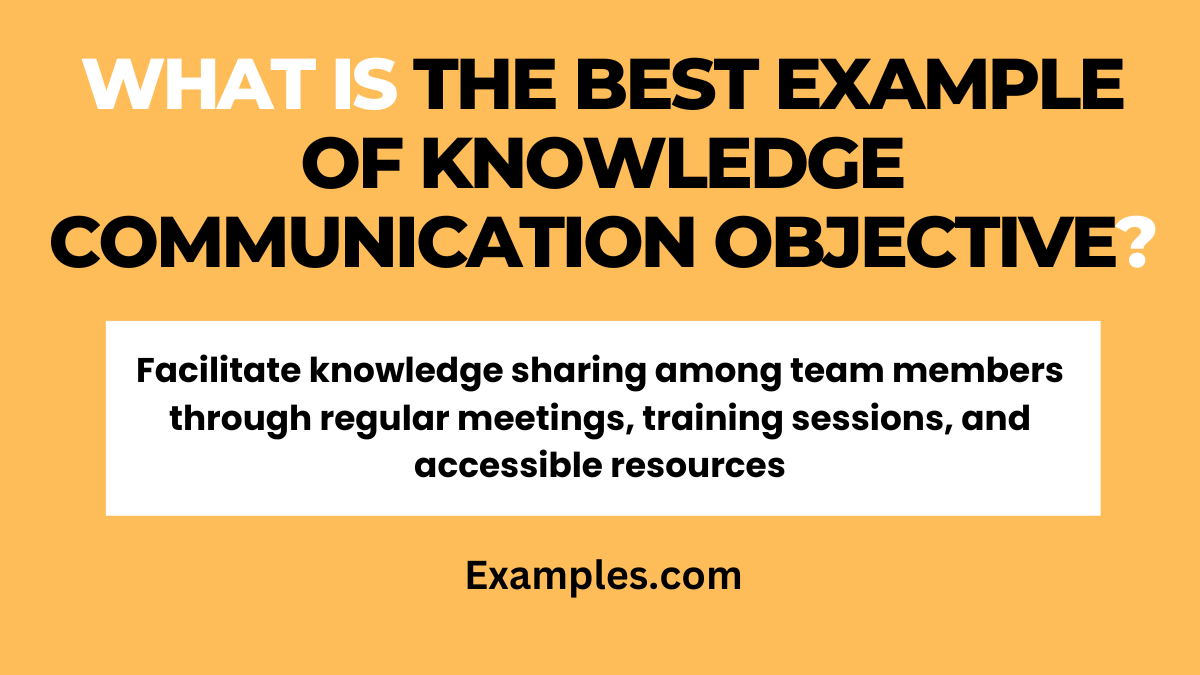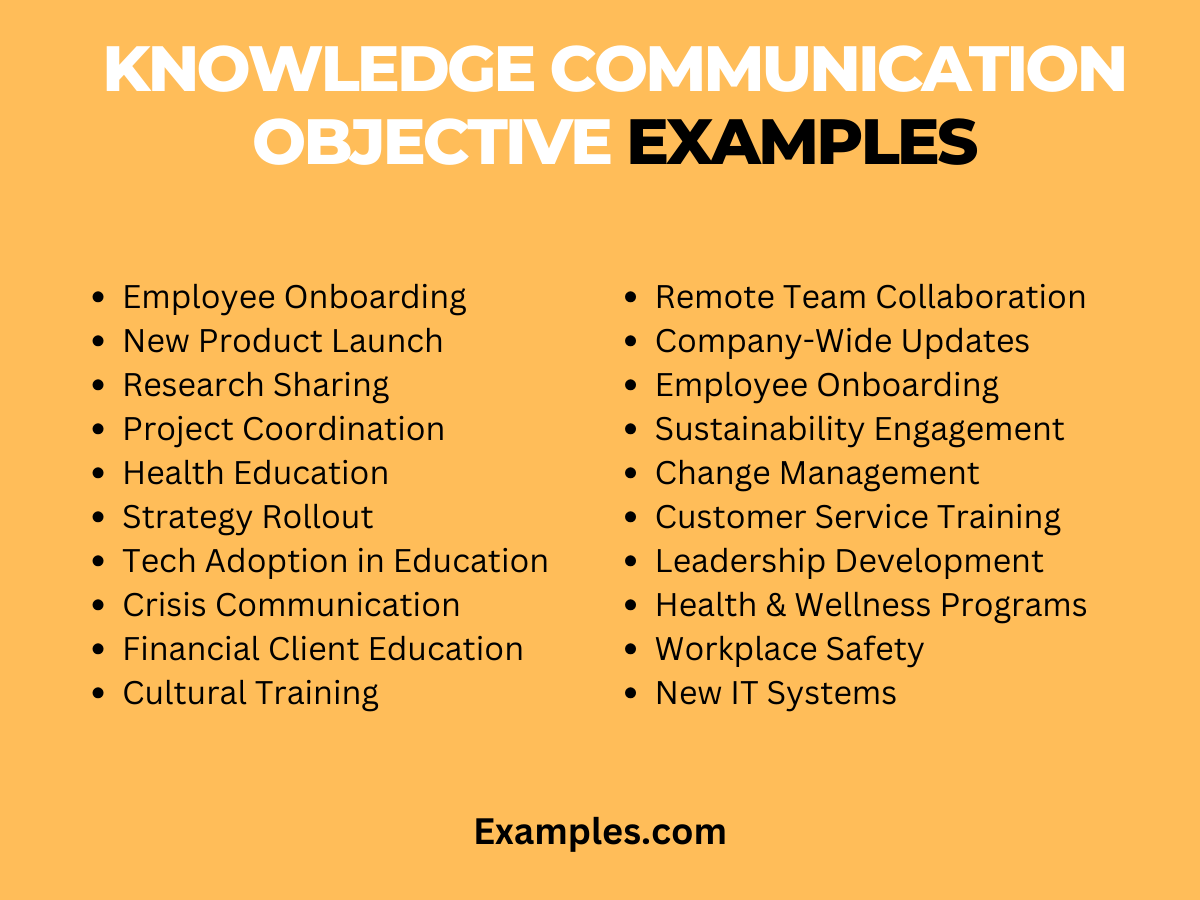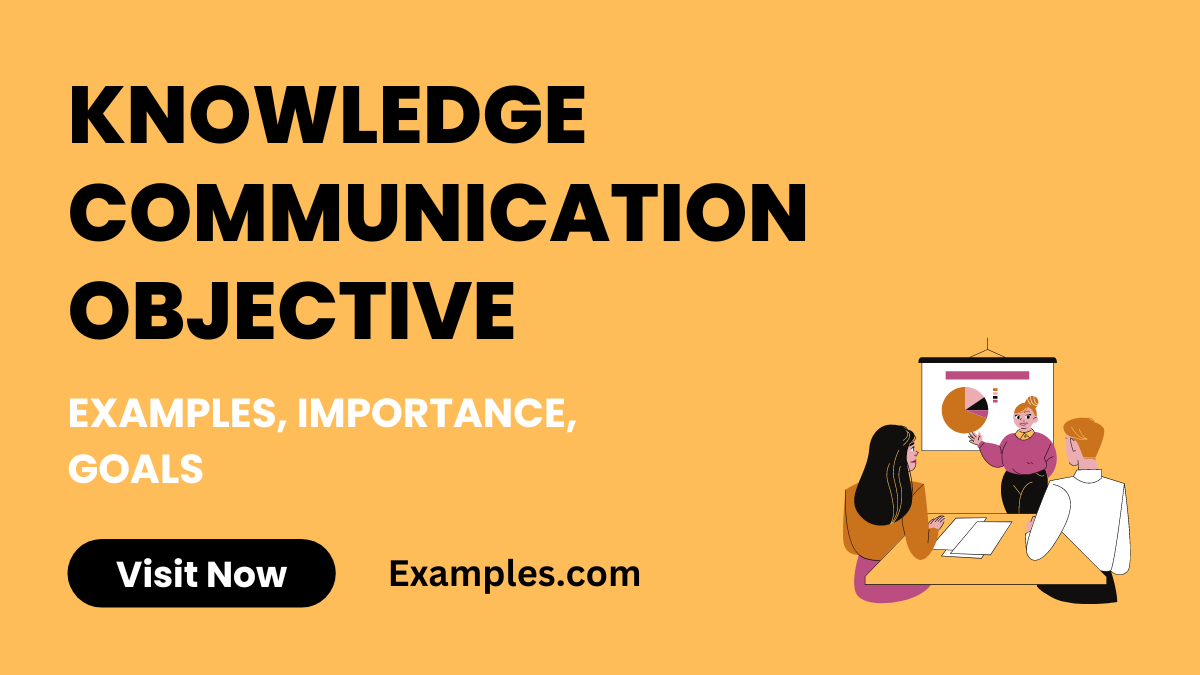19+ Knowledge Communication Objective Examples
Welcome to the comprehensive guide on Knowledge Communication Objective, an essential tool in today’s information-driven world. This guide delves into the art of effectively sharing and exchanging knowledge, covering everything from instructional communication strategies to real-world communication examples. We explore various types of communication objectives, such as awareness building communication objective, information dissemination communication objective, and persuasion, to help you master the nuances of transmitting knowledge in different settings. Whether it’s in education, business, or personal development, understanding and implementing these objectives can significantly enhance the way we share and absorb information.
Download Knowledge Communication Objectives PDF
What is the Knowledge Communication Objective?

Knowledge Communication Objective refers to the deliberate strategy of sharing and disseminating information and knowledge within an organization or community. It’s about more than just relaying facts; it’s about ensuring that the information is understood, internalized, and used effectively. This process involves a blend of educational information sharing and intellectual content dissemination to foster an environment where knowledge is not only transferred but also actively applied.
What is the Best Example of Knowledge Communication Objective?

A stellar example of Knowledge Communication Objective can be seen in a corporate training program aimed at upskilling employees. Here, the objective is not only to provide the workers with new skills (like software training) but also to ensure they understand and can apply these skills in their daily tasks. This involves a mix of effective knowledge transfer techniques and organizational learning methods, where interactive modules and hands-on training ensure that the knowledge is effectively communicated and retained.
10 Knowledge Communication Objective Examples

Discover the multifaceted aspects of Knowledge Communication Objective through these 10 unique examples. This objective is central to various Types of Communication Objectives, ranging from Persuasion Communication Objective to Behavior Change Communication Objective. Each illustrates different challenges in knowledge communication and provides insights on how to address them effectively, employing methods like informational outreach approaches and knowledge sharing best practices.
- Onboarding New Employees: New employees might struggle with absorbing a lot of information quickly. Fix this by using educational outreach objectives to create phased, easy-to-digest training modules.
- Launching a New Product: Communicating the intricacies of a new product to a non-technical audience can be challenging. Overcome this by utilizing intellectual collaboration tactics to simplify and clarify the information.
- Academic Research Sharing: Researchers often find it difficult to communicate complex findings to a general audience. Address this by employing academic information exchange strategies, like summarizing key findings in layman’s terms.
- Cross-Departmental Project Coordination: Misunderstandings can arise in multi-departmental projects due to jargon and differing expertise. Counter this with organizational learning methods to establish a common language and understanding.
- Community Health Education: Public health initiatives can fail if the community doesn’t understand or trust the information. Use informational outreach approaches to tailor messages that resonate with community values and concerns.
- Corporate Strategy Rollout: Employees may be resistant or confused about new strategic directions. Alleviate this by applying knowledge sharing best practices to articulate the vision and its benefits clearly.
- Technology Adoption in Education: Educators might resist new technology due to a lack of understanding. Address this by integrating instructional communication strategies to demonstrate the technology’s value in enhancing teaching.
- Crisis Communication: In times of crisis, misinformation can spread quickly. Combat this with clear, consistent messaging using effective knowledge transfer techniques.
- Client Education in Financial Services: Clients may not understand complex financial products. Tackle this by employing intellectual content dissemination methods that simplify and elucidate these concepts.
- Cultural Sensitivity Training: Cultural misunderstandings can occur in diverse workplaces. Use educational information sharing to foster mutual respect and understanding.
How to Improve Knowledge Communication Objective
Improving Knowledge Communication Objective involves strategies that enhance the clarity, effectiveness, and reach of knowledge sharing. In the context of employee development, Knowledge Communication Objective aligns closely with Employee Motivation Communication Objective and Leadership Communication Objective, ensuring that teams are not only informed but also skilled and motivated.This includes employing intellectual collaboration tactics and effective knowledge transfer techniques to ensure that the shared knowledge is not only disseminated but also effectively utilized.
- Utilize Diverse Communication Channels: Employ different mediums to cater to varied learning styles.
- Encourage Open Dialogue: Create a culture where questions and discussions are welcomed.
- Implement Regular Training and Workshops: Continuous learning opportunities for skill enhancement.
- Foster a Culture of Sharing: Encourage sharing of knowledge and experiences among peers.
- Leverage Technology for Knowledge Dissemination: Use digital tools for effective knowledge sharing.
- Provide Access to Resources and Materials: Ensure easy access to necessary learning materials.
- Evaluate and Adapt Communication Strategies: Regularly assess the effectiveness of communication methods and adapt as needed.
What are the Goals of Knowledge Communication Objective
The goals of Knowledge Communication Objective revolve around effectively disseminating knowledge to enhance understanding, skills, and capabilities. This involves incorporating instructional communication strategies and organizational learning methods to ensure that the objectives of knowledge communication are met effectively.
- Ensure Clear Understanding of Concepts: Aim for clarity in all communications.
- Build a Knowledgeable Workforce: Equip individuals with the necessary skills and knowledge.
- Encourage Continuous Learning and Development: Foster an environment of ongoing personal and professional development.
- Improve Collaboration and Teamwork: Use knowledge sharing to enhance collaboration.
- Support Innovation and Problem Solving: Foster an environment where creativity is encouraged.
- Facilitate Effective Decision Making: Ensure individuals have the knowledge needed to make informed decisions.
- Cultivate a Culture of Knowledge Sharing: Establish knowledge sharing as a core value.
Importance of Knowledge Communication Objectives
Understanding the Importance of Knowledge Communication Objectives is crucial in today’s information-centric world. It encompasses areas like informational outreach approaches and knowledge sharing best practices, highlighting how effective knowledge communication can significantly impact learning, productivity, and innovation.
- Enhances Learning and Understanding: Effective communication ensures that knowledge is comprehensively understood.
- Promotes Innovation and Creativity: Encourages sharing of ideas, leading to innovation.
- Improves Organizational Efficiency: Streamlined knowledge flow enhances productivity.
- Fosters Collaborative Work Environment: Knowledge sharing builds a collaborative culture.
- Supports Informed Decision Making: Well-informed individuals make better decisions.
- Aids in Personal and Professional Growth: Continuous learning leads to growth.
- Builds a Knowledge-Based Culture: Cultivates an environment where knowledge is valued.
Knowledge Communication Objective for Employees
Effective knowledge communication among employees is vital for any organization’s growth and efficiency. It involves strategies like effective knowledge transfer techniques and intellectual content dissemination to ensure that employees are well-informed, skilled, and aligned with organizational goals.
- Training on New Software: Equip employees with hands-on training and clear guidelines. Example: “Let’s go through this tutorial to understand the software’s features.”
- Policy Updates: Regularly communicate any changes in company policies. Example: “We have updated our leave policy, which you can view on the intranet.”
- Sharing Market Insights: Keep employees informed about industry trends. Example: “This report highlights current market trends that could impact our strategy.”
- Health and Safety Protocols: Clearly communicate health guidelines in the workplace. Example: “Please follow these safety procedures to ensure a healthy work environment.”
- Product Knowledge Sessions: Conduct sessions to enhance product understanding. Example: “Join this session to learn about our new product’s features and benefits.”
- Feedback Mechanisms: Implement systems for employees to share feedback. Example: “Your input on our internal processes is valuable; please use the feedback form.”
- Crisis Communication Plans: Prepare and share plans for potential crises. Example: “In case of an emergency, here’s our communication protocol.”
Knowledge Communication Objective in the Workplace
Knowledge Communication in the workplace is crucial for fostering a collaborative and informed work environment. It integrates instructional communication strategies and organizational learning methods to facilitate seamless knowledge sharing and enhance overall productivity.
- Inter-Departmental Workshops: Bridge knowledge gaps between different departments. Example: “Join our workshop to understand how our teams can collaborate more effectively.”
- Leadership Talks: Regular updates from leadership about company vision and progress. Example: “Our quarterly town hall meeting will provide updates on the company’s direction.”
- Collaborative Project Platforms: Use technology for easier project collaboration. Example: “Let’s use this platform for real-time project updates and information sharing.”
- Mentorship Programs: Pairing new employees with experienced mentors. Example: “Your mentor will guide you through our project management processes.”
- Knowledge Sharing Forums: Create forums for employees to share insights. Example: “This forum is for sharing your innovative ideas and best practices.”
- Customer Feedback Sharing: Regularly disseminate customer feedback to relevant teams. Example: “Here’s what our customers are saying about our latest product.”
- Training on Company Culture: Educate new hires about the company’s values and culture. Example: “Our culture orientation session will help you understand our core values better.”
Knowledge Communication Objective for Students
Knowledge Communication for students is pivotal in educational settings, focusing on educational information sharing and academic information exchange.To establish these objectives, it’s important to address Communication Objective Questions like How to Write a Communication Objective? and How to Determine Communication Objectives? It ensures students are effectively receiving and comprehending educational content, fostering a conducive learning environment.
- E-Learning Modules: Offer interactive and engaging online learning resources. Example: “These modules are designed to help you understand complex concepts easily.”
- Study Group Sessions: Encourage peer-to-peer learning and discussion. Example: “Joining study groups can enhance your understanding of the subject matter.”
- Guest Lectures from Industry Experts: Bring real-world perspectives into the classroom. Example: “Next week’s guest lecture will provide insights into the current industry trends.”
- Research Project Guidance: Provide support for undertaking research projects. Example: “We will guide you through each step of your research project.”
- Feedback on Assignments: Give constructive feedback to help students improve. Example: “Your assignment shows good understanding, but here’s how you can improve further.”
- Career Counseling Sessions: Offer advice on academic and career choices. Example: “Our counseling sessions can help you align your studies with your career goals.”
- Interactive Classroom Discussions: Foster an environment of open dialogue in classrooms. Example: “Let’s discuss your thoughts on this topic to deepen our understanding.”
And ensuring they align with the broader goals of Strategic Communication Objectives. Whether in the context of Communication Objectives for Therapy, Communication Objectives for Treatment Plans, or more corporate settings like Communication Objectives in Business and Communication Objectives in an Organization.
In the business world, the Knowledge Communication Objective is vital for internal and external communication. For example, McKinsey & Company (McKinsey Insights) offers numerous articles and studies on how effective knowledge communication can enhance organizational performance, drive innovation, and improve employee engagement.
Healthcare is another sector where knowledge communication is critical. The Centers for Disease Control and Prevention (CDC) (CDC Health Communication) provides guidelines and tools for effective health communication. These resources are crucial for healthcare professionals to communicate effectively with patients and the public, particularly in times of health crises or when conveying public health guidelines.



